
Browse multidimensional data (OLAP) organized into dimensions, measures, named sets, and KPIs in a cube format with the WPF OLAP Browser. You can visualize the results in graphical (OLAP Chart) and table (OLAP Grid) formats. The control can also be used to create and edit reports at runtime that can be stored for later use.
The WPF OLAP Browser control enables you to retrieve multidimensional data (OLAP) from SSAS or any XML/A provider. The data sources supported are SSAS, Mondrian, ActivePivot, and Oracle.

End users can enable built-in features in the OLAP Grid either through UI or a simple, user-friendly API in the code-behind.
For more details about the built-in OLAP Grid features, check out the documentation
End users can enable built-in features of the OLAP Chart either through UI or a simple, user-friendly API in the code-behind.
For more details about the built-in OLAP Chart features, check out the documentation

Slice and dice creates a new view for end users by selecting limited dimensions and measures from the cube and filtering them.

KPIs are a collection of calculations associated with a measure group that evaluates business success. A few KPIs are defined and listed when the OLAP Cube is created.

Users can create their own KPIs at runtime and write expressions as well. In an expression, positive numbers will be represented by a green light or up arrow, and negative numbers will be represented by a red light or down arrow, depending on the users preferences.
The named sets simplify MDX queries and provide useful aliases for complex, commonly used set expressions.


You can create and display your own dimensions and measures at runtime.
Member properties provide basic information about each member in each tuple, including member name, parent level, and number of children. These member properties are available for all members at any given level, and can be enabled in reports programmatically.

There is built-in support for drilling down (expand) and drilling up (collapse) to visualize the OLAP Grid and OLAP Chart information in both abstract and detailed views.
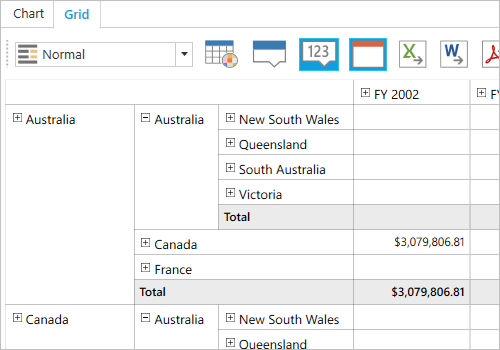
This option delivers a detailed view of any selected member while drilling down and shows an abstract view after drilling up.

You can choose to drill only at the current position of a selected member.

The axis element builder is similar to the pivot table field list in Excel, and allows you to create and manage the control with multidimensional (OLAP) data sources. End users can drag hierarchies and filter them to create reports at runtime.
Organizes the selected OLAP cube’s elements such as dimensions, hierarchies, measures, KPIs, named sets, and more in a tree-like structure.
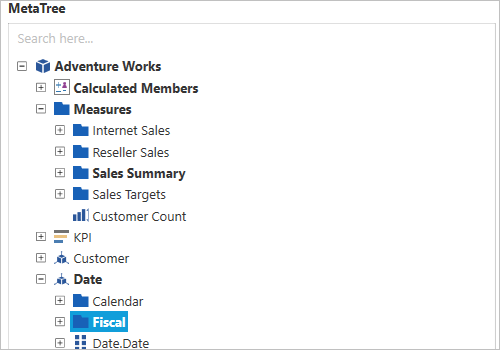
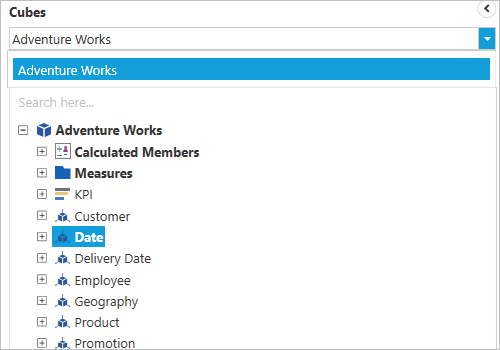
Allows you to select any of the cubes available in the connected database. Based on the selected cube, the corresponding cube element is loaded into the control.
With built-in filtering options, you can easily filter and visualize data. It is also possible to filter programmatically.
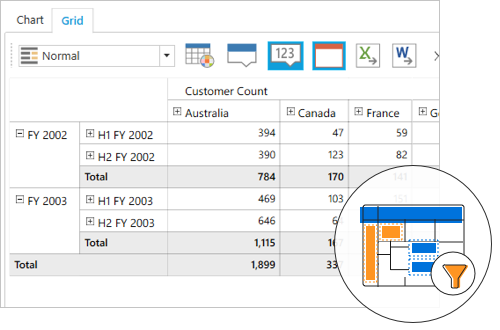
You can filter the headers in rows and columns based on hierarchy members to selectively display records.
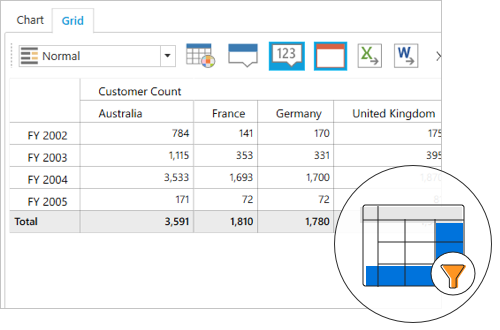
You can filter the results in rows and columns based on active measures to selectively display records.


Extensive support has been provided to load and render a large amount of data without any performance constraints through paging.
The member editor dialog displays members of the selected hierarchy in a tree-like structure for easy filtering. When a large number of members is bound to the member editor, lazy loading is enabled automatically.
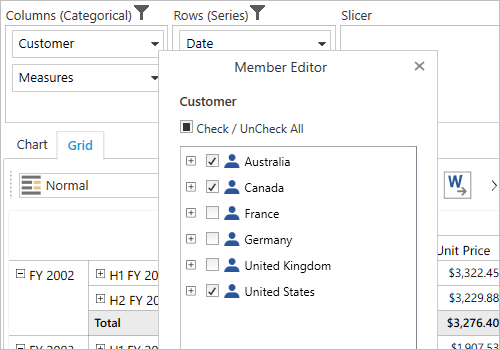

The measure editor dialog displays a collection of measures from the current report. You can apply filters, reorder them, and remove a specific measure from the current report at runtime.


The following options are available in the toolbar to perform common reporting operations:
Allows users to render the control in different layouts with the help of the following built-in features:


You can save reports from the current session in XML format for later use. You can also save and load reports from databases programmatically.

Ships with built-in themes like Blend, Office 2010, Office 2007, Office 2003, Transparent, and Metro.

You can customize the control’s appearance to any extent in code-behind.
For a great developer experience, flexible built-in APIs are available to define and customize the WPF OLAP Browser. Developers can optimize the data bound to the control and customize the user interface (UI) completely using code with ease.

Allows users from different locales to use the control by applying appropriate date formats, currency formats, and number formats.

The text direction and layout of the control can be displayed in from right-to-left(RTL).
 Documentation
Documentation
Greatness—it’s one thing to say you have it, but it means more when others recognize it. Syncfusion® is proud to hold the following industry awards.